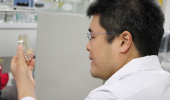領域名 植物科学
教員氏名 望 月 進
研究分野 希少糖遺伝子工学

研究キーワード:希少糖,遺伝子,植物,微生物,植物-微生物間相互作用

最近の研究課題
1.希少糖生産遺伝子に関する研究
これまでに香川大学では、Izumoring戦略による各種の希少糖変換酵素の単離を行い、量産化が開始されたD-プシコースを初めとする全ての希少糖生産を可能にしてきた。我々の研究室では、微生物や植物から希少糖生産酵素遺伝子資源を発掘するとともに、生産酵素の機能を解析・改良することによって、あらゆる希少糖の高効率で迅速な生産を目指している。

2.希少糖作用メカニズムに関する研究
希少糖は香川大学を中心とした各種研究により、食品、医薬、農薬と各方面への普及効果が期待されている。一方で、希少糖の作用機作に関する研究はまだ少ない。希少糖の様々な分野への有効活用を促進するために、植物や微生物を研究材料として、希少糖作用、特に希少糖のリン酸化と代謝に関する研究を行っている。

3.植物-微生物間相互作用時に機能する遺伝子の解析
微生物は糖を変換する能力を持ち、植物は糖を蓄積する能力を持つ。その境界領域である植物-微生物間相互作用の場では多様な応答が起こり、一次代謝や二次代謝に関係する多くの遺伝子発現が変動していることもわかっている。我々の研究室では、イネいもち病菌やAlternaria属菌を中心とした植物病原菌感染時の糖代謝を中心とした代謝関連遺伝子の機能解析を、植物側、微生物側の両方の視点から行っている。


代表的な研究業績
- Nishimura, T., Mochizuki, S. et al. (2016) Magnaporthe oryzae Glycine-Rich Secretion Protein, Rbf1 Critically Participates in Pathogenicity through the Focal Formation of the Biotrophic Interfacial Complex, PLOS Pathogens, 12(10), e1005921.
- Mochizuki, S. et al. (2015) Live-cell imaging of rice cytological changes reveals the importance of host vacuole maintenance for biotrophic invasion by blast fungus, Magnaporthe oryzae, MicrobiologyOpen, 4(6), 952-966.
- Mochizuki, S. et al. (2014) Ubiquitin ligase EL5 maintains the viability of root meristems by influencing cytokinin-mediated nitrogen effects in rice, Journal of Experimental Botany, 65(9), 2307-2318.
- Kouzai, Y. et al. (2014) Targeted Gene Disruption of OsCERK1 Reveals Its Indispensable Role in Chitin Perception and Involvement in the Peptidoglycan Response and Immunity in Rice, Molecular Plant-Microbe Interactions, 27(9), 975-982.
- Sakai, T., Mochizuki, S. et al. (2012) The WAVY GROWTH 3 E3 ligase family controls the gravitropic response in Arabidopsis roots, The Plant Journal, 70, 303-314.
- Mochizuki, S. et al. (2011) Localization of probe-accessible chitin and characterization of genes encoding chitin-binding domains during rice–Magnaporthe oryzae interactions, Journal of General Plant Pathology, 77, 163-173.
Research Area: Plant Science
Research Field: Rare sugar molecular biology
Name: MOCHIZUKI, Susumu

Keywords: Rare sugars, Genetic Functions, Plant biology, Microbiology, Plant-Microbe interactions

Recent Research
1. Rare sugar production
Several sugar converting enzymes were isolated at Kagawa University using the Izumoring strategy. These enzymes made it possible to produce many types of rare sugars, including D-allulose. Prompted by the growing industrial potential of rare sugars, the present study aims to select the best enzymes for production of rare sugars, and to improve their production efficiency by using genetic engineering methods.

2. Functional mechanisms of rare sugars
These rare sugars can potentially be used for many applications, including in health food products, pharmaceutical products, and agricultural materials. However, the functional mechanisms of rare sugars have not yet been clarified. To gain a better understanding of how rare sugars act upon living cells, we are analyzing gene functions in sugar-treated plants and microbes.

3. Plant-microbe interaction
Microorganisms have the ability to produce these sugars, and plants are able to store them. Many primary and secondary metabolism-related genes function in both plants and microbes during their interaction. To understand sugar and sugar-related metabolisms in more detail, we are analyzing the functions of these genes during interactions between plants and plant pathogenic fungi (Magnaporthe and Alternaria).


Publications
- Nishimura, T., Mochizuki, S. et al. (2016) Magnaporthe oryzae Glycine-Rich Secretion Protein, Rbf1 Critically Participates in Pathogenicity through the Focal Formation of the Biotrophic Interfacial Complex, PLOS Pathogens, 12(10), e1005921.
- Mochizuki, S. et al. (2015) Live-cell imaging of rice cytological changes reveals the importance of host vacuole maintenance for biotrophic invasion by blast fungus, Magnaporthe oryzae, MicrobiologyOpen, 4(6), 952-966.
- Mochizuki, S. et al. (2014) Ubiquitin ligase EL5 maintains the viability of root meristems by influencing cytokinin-mediated nitrogen effects in rice, Journal of Experimental Botany, 65(9), 2307-2318.
- Kouzai, Y. et al. (2014) Targeted Gene Disruption of OsCERK1 Reveals Its Indispensable Role in Chitin Perception and Involvement in the Peptidoglycan Response and Immunity in Rice, Molecular Plant-Microbe Interactions, 27(9), 975-982.
- Sakai, T., Mochizuki, S. et al. (2012) The WAVY GROWTH 3 E3 ligase family controls the gravitropic response in Arabidopsis roots, The Plant Journal, 70, 303-314.
- Mochizuki, S. et al. (2011) Localization of probe-accessible chitin and characterization of genes encoding chitin-binding domains during rice–Magnaporthe oryzae interactions, Journal of General Plant Pathology, 77, 163-173.
このページの管理者:管理者















